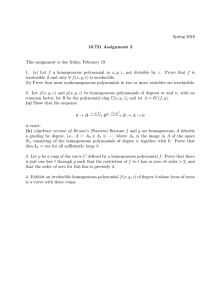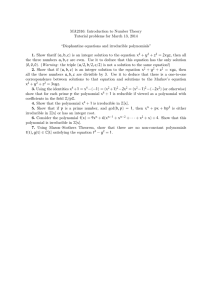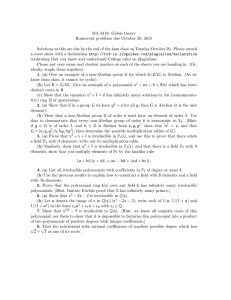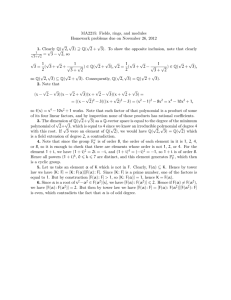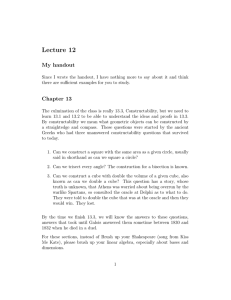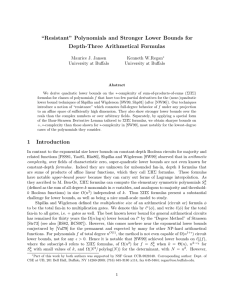2016 18.721 Comments on Assignment 2
advertisement
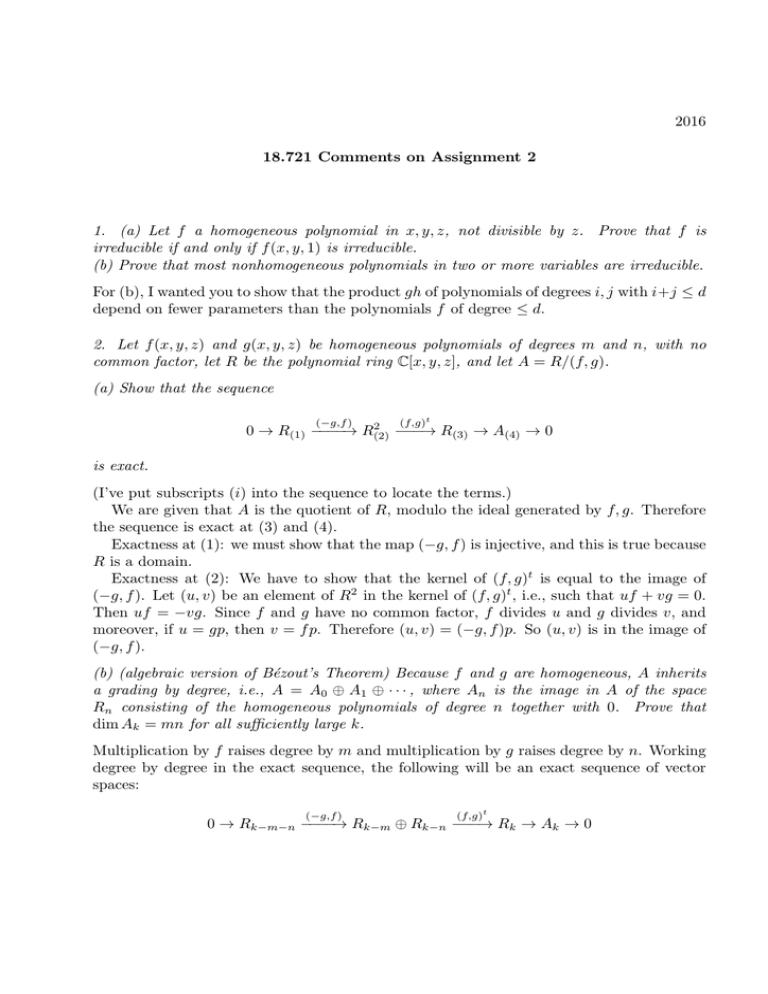
2016 18.721 Comments on Assignment 2 1. (a) Let f a homogeneous polynomial in x, y, z, not divisible by z. Prove that f is irreducible if and only if f (x, y, 1) is irreducible. (b) Prove that most nonhomogeneous polynomials in two or more variables are irreducible. For (b), I wanted you to show that the product gh of polynomials of degrees i, j with i+j ≤ d depend on fewer parameters than the polynomials f of degree ≤ d. 2. Let f (x, y, z) and g(x, y, z) be homogeneous polynomials of degrees m and n, with no common factor, let R be the polynomial ring C[x, y, z], and let A = R/(f, g). (a) Show that the sequence (−g,f ) (f,g)t 2 0 → R(1) −−−−→ R(2) −−−→ R(3) → A(4) → 0 is exact. (I’ve put subscripts (i) into the sequence to locate the terms.) We are given that A is the quotient of R, modulo the ideal generated by f, g. Therefore the sequence is exact at (3) and (4). Exactness at (1): we must show that the map (−g, f ) is injective, and this is true because R is a domain. Exactness at (2): We have to show that the kernel of (f, g)t is equal to the image of (−g, f ). Let (u, v) be an element of R2 in the kernel of (f, g)t , i.e., such that uf + vg = 0. Then uf = −vg. Since f and g have no common factor, f divides u and g divides v, and moreover, if u = gp, then v = f p. Therefore (u, v) = (−g, f )p. So (u, v) is in the image of (−g, f ). (b) (algebraic version of Bézout’s Theorem) Because f and g are homogeneous, A inherits a grading by degree, i.e., A = A0 ⊕ A1 ⊕ · · · , where An is the image in A of the space Rn consisting of the homogeneous polynomials of degree n together with 0. Prove that dim Ak = mn for all sufficiently large k. Multiplication by f raises degree by m and multiplication by g raises degree by n. Working degree by degree in the exact sequence, the following will be an exact sequence of vector spaces: (−g,f ) (f,g)t 0 → Rk−m−n −−−−→ Rk−m ⊕ Rk−n −−−→ Rk → Ak → 0 2 Therefore dim Ak − dim Rk + (dim(Rk−m + dim Rk−n ) − dim Rk−m−n = 0. One determines that dim Rk = k+2 2 . Then k+2 k−m+2 k−n k−m−n+2 dim Ak = − − + 2 2 2 2 This works out to mn. 4. Exhibit an irreducible homogeneous polynomial f (x, y, z) of degree 4 whose locus of zeros is a curve with three cusps. We choose coordinates so that the cusps are the coordinate vertices. Since the cusps are double points, the coefficients of x4 , x3 y, x3 z, y 4 , xy 3 , y 3 z, z 4 , xz 3 , yz 3 in f will be zero, leaving us with a combination of x2 y 2 , x2 z 2 , y 2 z 2 , x2 yz, xy 2 z, xyz 2 . Let’s try normalizing the first three coefficients to 1: f = (x2 y 2 + x2 z 2 + y 2 z 2 ) + (ax2 yz + bxy 2 z + cxyz 2 ). Setting z = 1, the quadratic term x2 + y 2 + cxy is supposed to be a square. So c = ±2. Similarly, a = ±2 and b = ±2. The polynomial (x2 y 2 + x2 z 2 + y 2 z 2 ) ± 2(x2 yz + xy 2 z − xyz 2 ) is one possibility. However, when the sign is +, this polynomial is equal to (xy + xz + yx)2 . Not irreducible, therefore not good. We try the sign −: f = (x2 y 2 + x2 z 2 + y 2 z 2 ) − 2(x2 yz + xy 2 z − xyz 2 ) The symmetry of this polynomial helps show that it is irreducible. If ax + by + cz divides f , then so do ax + cy + bz and bx + cy + az. Thinking this through, one sees that the only possible linear factor is x + y + z. But the point (1, −1, 0) lies on that line and not on f = 0. So there is no linear factor. Suppose that f = gh is a product of quadratic polynomials. If the coefficient of x2 in g were nonzero, then because there is no opccurence of x3 or x4 in f , h would be a polynomial in y, z, and it would factor into linear factors. So x2 has zero coefficient in g, as do y 2 and z 2 . Therefore g and h must be combinations of xy, xz, yz, and by symmetry they must be xy + xz + yz, up to scalar factor. We’ve already seen what the square of this polynomial is.
